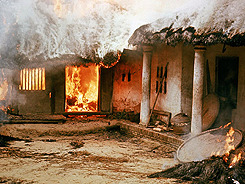![]()
![]()
![]()
![]()
![]()
![]()
Die with a degree of dignity. Lay down your life with dignity; don’t lay down with tears and agony.
November 18, 1978: 909 Peoples Temple members die at Jonestown.
Jim Jones’s notorious religious organization was founded in 1955 and, at its peak, had a purported membership of around 20,000 people. Jones was a fervent supporter of racial integration; in fact, one the Peoples Temple’s early objectives was the formation of a safe, interracial religious congregation. In 1961, Jones claimed to have had a vision of a coming nuclear holocaust, which would destroy Indianapolis and destroy capitalism (“the Antichrist system”), leaving only a “socialist Eden” behind. As the Peoples Temple worked to pursue Jones’ “apostolic Socialism”, it subjected its members to a kind of mind control and psychological manipulation that taught members to shun those Jones deemed “enemies” and “traitors”. At the same time, the charismatic Jones made himself out to be a figure to be worshipped; he attacked mainstream religion, which he referred to as an “opiate” (and the Bible as a “paper idol”).
In the mid-1970s, Jonestown (officially called the “Peoples Temple Agricultural Project”) was established in Guyana as a communist utopia for Jones’ most fervent followers. Jones addressed his congregation through radio broadcasts in which he praised Joseph Stalin and Robert Mugabe while attacking the United States’ imperialist policy. Discontent still stirred among Temple members, however. When California Congressman Leo Ryan flew out to Guyana to visit Jonestown on November 17, 1978, several members requested the congressman’s aid returning to the United States. When Ryan and the defectors reached the airstrip to depart, one of the accompanying Temple members drew a gun and killed a cameraman, photographer, NBC reporter, and Congressman Ryan, who had planned to describe the community “in basically good terms” in the report he planned to issue once returning to the United States.
Shortly after, Jones delivered to his hundreds of remaining Temple members an address in which he encouraged them to commit “revolutionary suicide”, while his aides prepared a metal vat full of Flavor Aid (a drink similar to Kool-Aid) laced with various drugs, along with cyanide. Many drank the concoction; others were pressured to do so, while children under a certain age were injected with the poison by their parents. Nearly three hundred children died at Jonestown; thirty-three members survived. Jim Jones himself was found dead by a gunshot wound to the head, most likely self-inflicted. During the suicides, Jones had reportedly encouraged his followers with these words:
I don’t care how many screams you hear, I don’t care how many anguished cries…death is a million times preferable to ten more days of this life. If you knew what was ahead of you – if you knew what was ahead of you, you’d be glad to be stepping over tonight.










































































